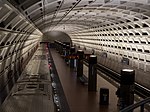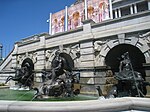The Library of Congress (LOC) is a research library in Washington, D.C., that serves as the library of the U.S. Congress and the de facto national library of the United States. Founded in 1800, the library is the United States's oldest federal cultural institution. The Library is housed in three elaborate buildings on Capitol Hill. It also maintains a conservation center in Culpeper, Virginia. The library's functions are overseen by the Librarian of Congress, and its buildings are maintained by the Architect of the Capitol. The Library of Congress is one of the two largest libraries in the world, along with the British Library. Its collections contain approximately 173 million items, and it has more than 3,000 employees. Its "collections are universal, not limited by subject, format, or national boundary, and include research materials from all parts of the world and in more than 470 languages."Congress moved to Washington, D.C., in 1800 after holding sessions for eleven years in the temporary national capitals in New York City and Philadelphia. In both cities, members of the U.S. Congress had access to the sizable collections of the New York Society Library and the Library Company of Philadelphia. The small Congressional Library was housed in the United States Capitol for most of the 19th century, until the early 1890s.
Most of the original collection was burnt by British forces during the War of 1812. The library began to restore its collection in 1815. The library purchased Thomas Jefferson's entire personal collection of 6,487 books. Over the next few years, its collection slowly grew, but in 1851, another fire broke out in the Capitol chambers. This destroyed a large amount of the collection, including many of Jefferson's books. After the American Civil War, the importance of the Library of Congress increased with its growth, and there was a campaign to purchase replacement copies for volumes that had been burned. The library received the right of transference of all copyrighted works to deposit two copies of books, maps, illustrations, and diagrams printed in the United States. It also began to build its collections. Its development culminated between 1888 and 1894 with the construction of its own separate, large library, now known as the Thomas Jefferson Building, across the street from the Capitol. Two more adjacent library buildings, the John Adams Building, built in the 1930s, and the James Madison Memorial Building, built in the 1970s, hold expanded parts of the collection and provide space for additional library services.
The library's primary mission is to research inquiries made by members of Congress, which is carried out through the Congressional Research Service. It also houses and oversees the United States Copyright Office. The library is open to the public for research, although only high-ranking government officials and library employees may check out (i.e., remove from the premises) books and materials.










